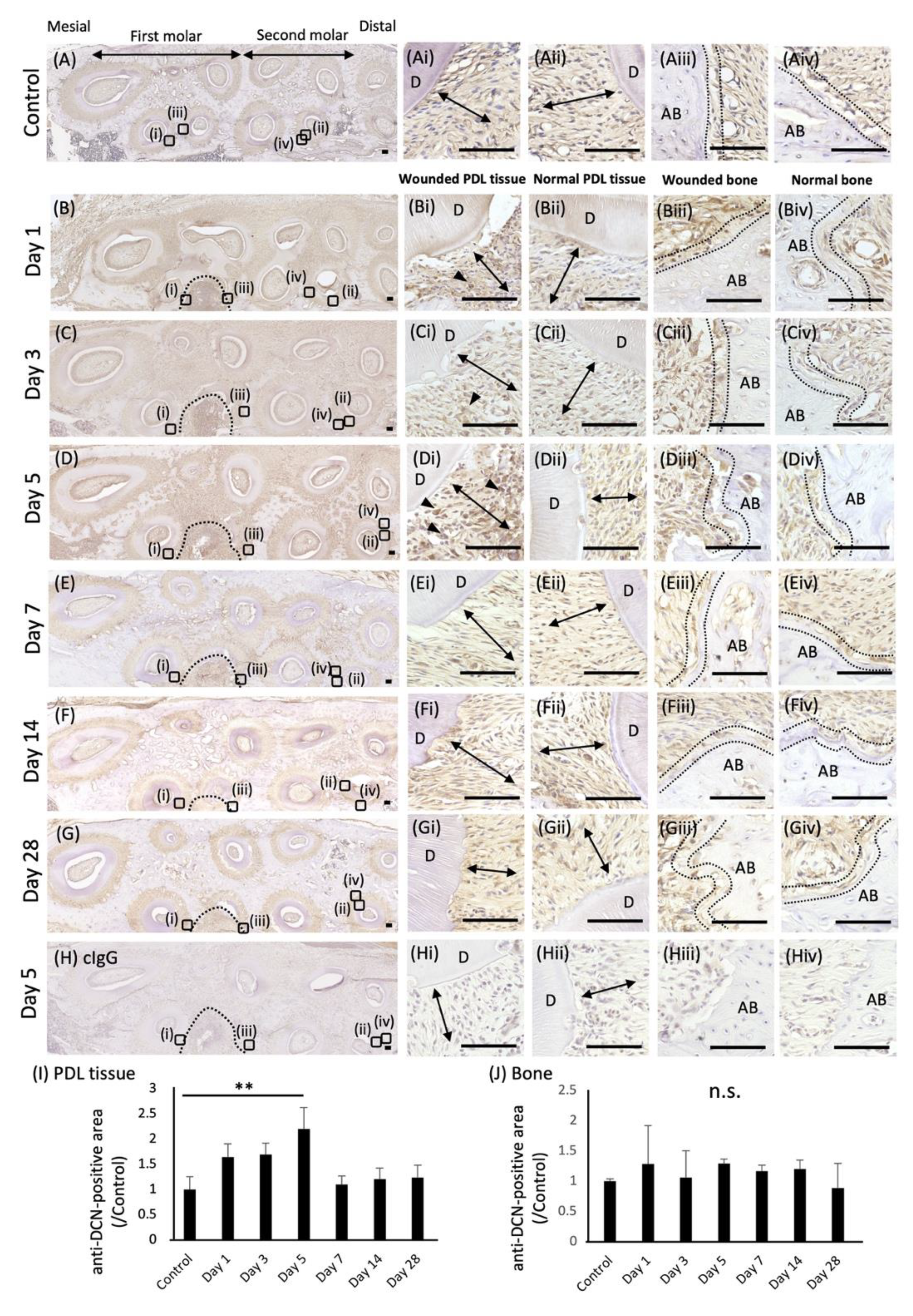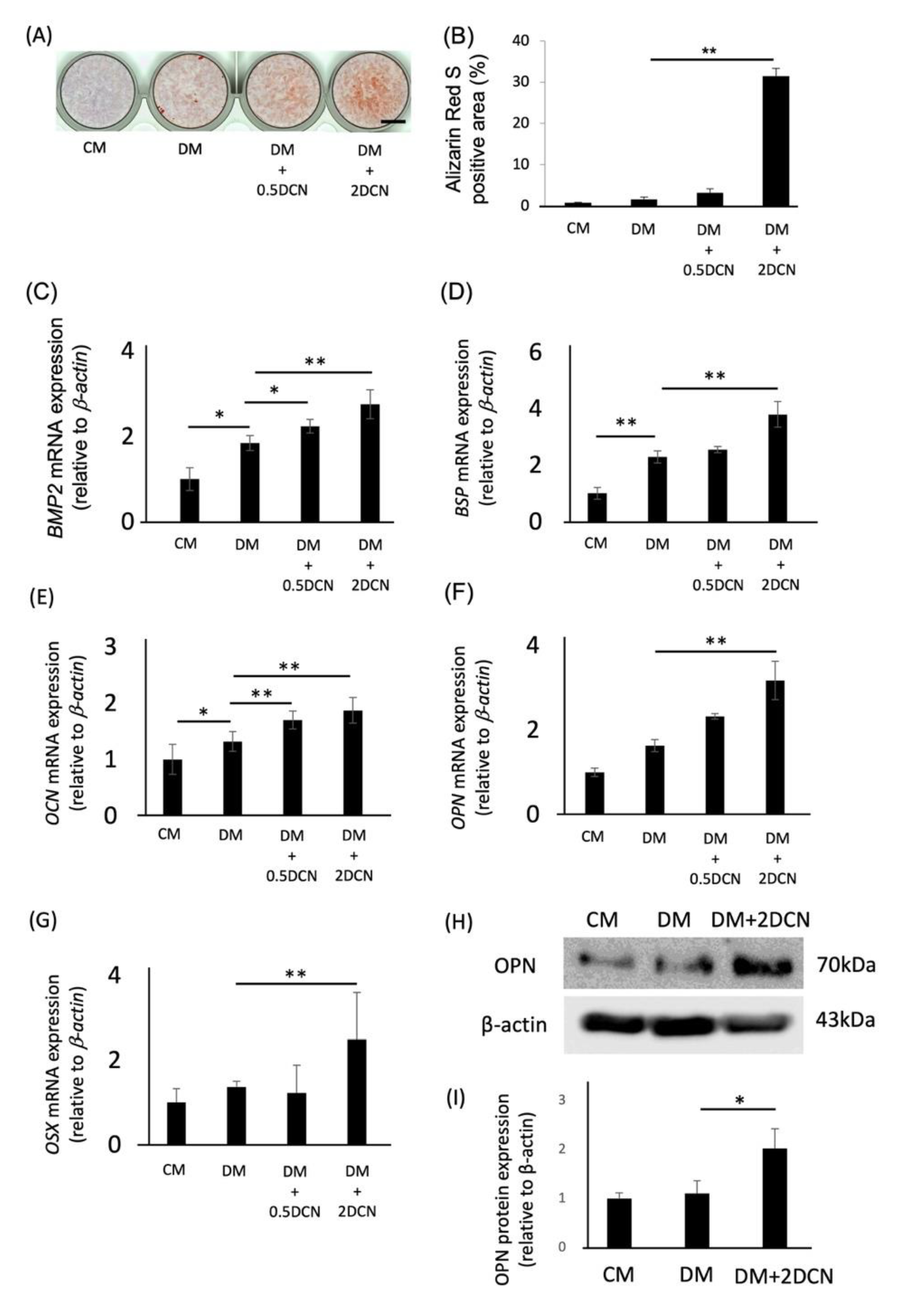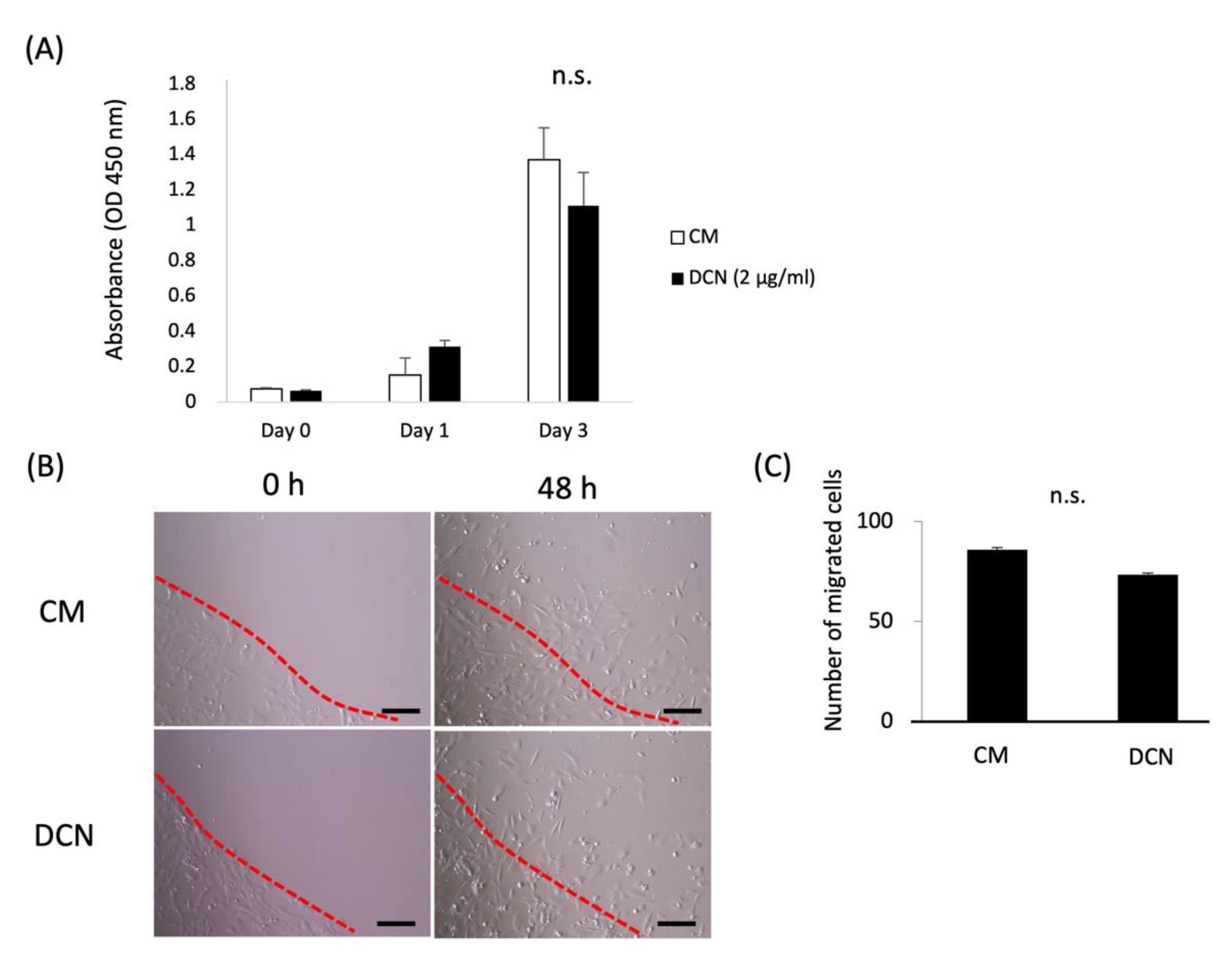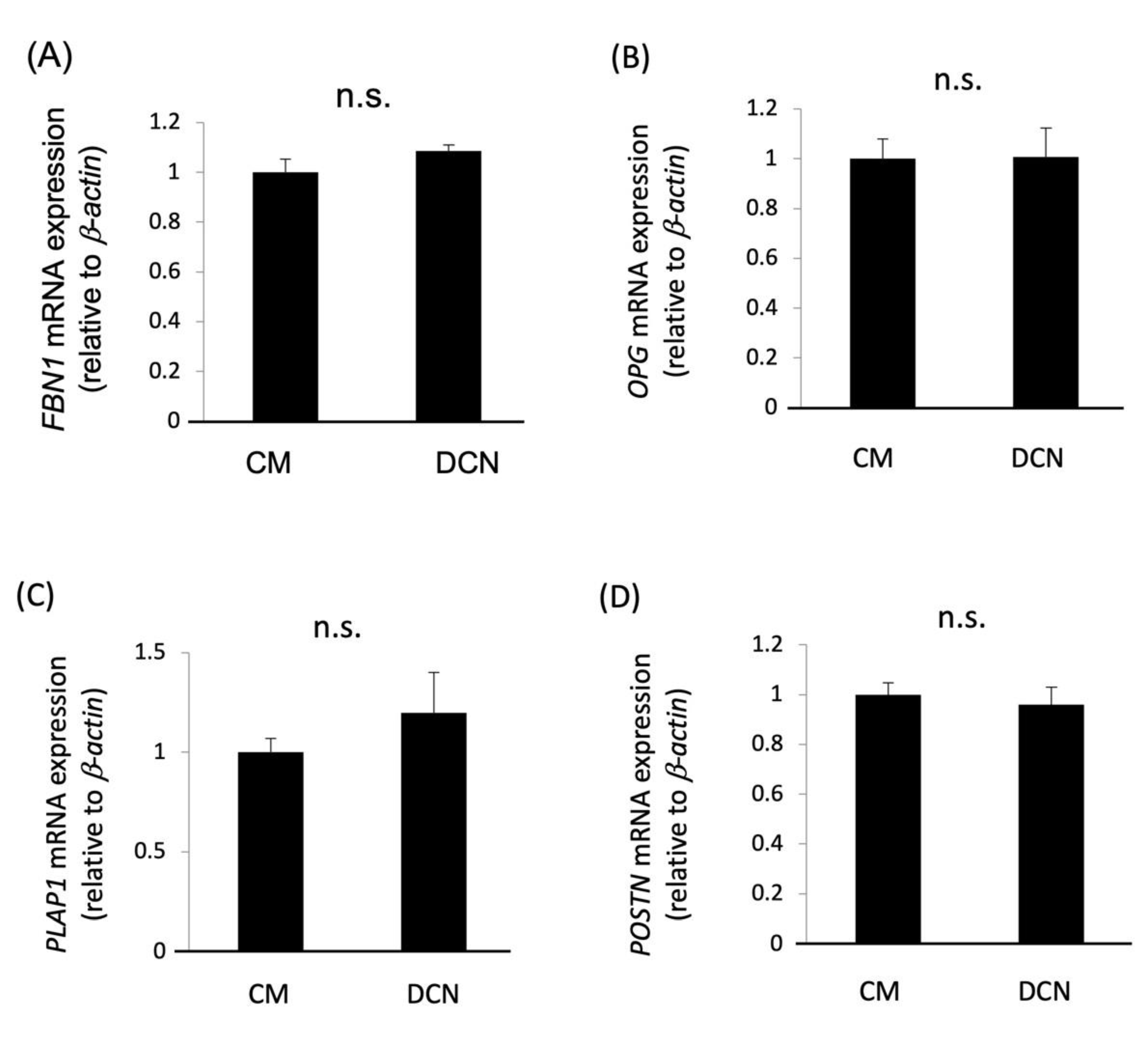Decorin Promotes Osteoblastic Differentiation of Human Periodontal Ligament Stem Cells
Abstract
1. Introduction
2. Results
2.1. Expression of DCN in Wounded Rat Periodontal Tissue
2.2. Expression of DCN in Human PDL Cells Treated with IL-1β and TNF-α
2.3. Effects of DCN on the Osteoblastic Differentiation of HPDLSCs and Preosteoblasts
2.4. Phosphorylation of ERK1/2 in DCN-Treated HPDLSCs
2.5. Effects of DCN on the Proliferation, Migration, and PDL-Related Gene Expression of HPDLSCs
3. Discussion
4. Materials and Methods
4.1. Cell Culture
4.2. Decorin (DCN) Coating
4.3. Animal Model
4.4. Immunochemical Analysis
4.5. Treatment of Human PDL Cells with IL-1β and TNF-α
4.6. Osteoblastic Differentiation of HPDLSCs and Preosteoblasts
4.7. Quantitative RT-PCR
4.8. Western Blotting
4.9. WST-1 Proliferation Assay
4.10. Cell Migration Assay
4.11. Cytoskeletal Staining
4.12. Statistical Analysis
5. Conclusions
Supplementary Materials
Author Contributions
Funding
Institutional Review Board Statement
Informed Consent Statement
Data Availability Statement
Acknowledgments
Conflicts of Interest
References
- Polzer, I.; Schimmel, M.; Müller, F.; Biffar, R. Edentulism as part of the general health problems of elderly adults. Int. Dent. J. 2010, 60, 143–155. [Google Scholar] [PubMed]
- Fleischmannova, J.; Matalova, E.; Sharpe, P.T.; Misek, I.; Radlanski, R.J. Formation of the tooth-bone interface. J. Dent. Res. 2010, 89, 108–115. [Google Scholar] [CrossRef] [PubMed]
- Kim, M.G.; Park, C.H. Tooth-Supporting Hard Tissue Regeneration Using Biopolymeric Material Fabrication Strategies. Molecules 2020, 25, 4802. [Google Scholar] [CrossRef] [PubMed]
- Tomokiyo, A.; Yoshida, S.; Hamano, S.; Hasegawa, D.; Sugii, H.; Maeda, H. Detection, Characterization, and Clinical Application of Mesenchymal Stem Cells in Periodontal Ligament Tissue. Stem Cells Int. 2018, 2018, 5450768. [Google Scholar] [CrossRef]
- Ouchi, T.; Nakagawa, T. Mesenchymal stem cell-based tissue regeneration therapies for periodontitis. Regen Ther. 2020, 14, 72–78. [Google Scholar] [CrossRef]
- Li, X.; Gong, P.; Liao, D. In vitro neural/glial differentiation potential of periodontal ligament stem cells. Arch. Med. Sci. 2010, 6, 678–685. [Google Scholar] [CrossRef]
- Fujii, S.; Maeda, H.; Wada, N.; Tomokiyo, A.; Saito, M.; Akamine, A. Investigating a clonal human periodontal ligament progenitor/stem cell line in vitro and in vivo. J. Cell Physiol. 2008, 215, 743–749. [Google Scholar] [CrossRef]
- Jin, H.; Choung, H.W.; Lim, K.T.; Jin, B.; Jin, C.; Chung, J.H.; Choung, P.H. Recombinant Human Plasminogen Activator Inhibitor-1 Promotes Cementogenic Differentiation of Human Periodontal Ligament Stem Cells. Tissue Eng. Part A 2015, 21, 2817–2828. [Google Scholar] [CrossRef]
- Shi, S.; Bartold, P.M.; Miura, M.; Seo, B.M.; Robey, P.G.; Gronthos, S. The efficacy of mesenchymal stem cells to regenerate and repair dental structures. Orthod. Craniofac. Res. 2005, 8, 191–199. [Google Scholar] [CrossRef]
- Corsi, A.; Xu, T.; Chen, X.D.; Boyde, A.; Liang, J.; Mankani, M.; Sommer, B.; Iozzo, R.V.; Eichstetter, I.; Robey, P.G.; et al. Phenotypic effects of biglycan deficiency are linked to collagen fibril abnormalities, are synergized by decorin deficiency, and mimic Ehlers-Danlos-like changes in bone and other connective tissues. J. Bone Miner. Res. 2002, 17, 1180–1189. [Google Scholar] [CrossRef]
- Mohan, R.R.; Tovey, J.C.; Gupta, R.; Sharma, A.; Tandon, A. Decorin biology, expression, function and therapy in the cornea. Curr. Mol. Med. 2011, 11, 110–128. [Google Scholar] [CrossRef] [PubMed]
- Theocharis, A.D.; Karamanos, N.K. Decreased biglycan expression and differential decorin localization in human abdominal aortic aneurysms. Atherosclerosis 2002, 165, 221–230. [Google Scholar] [CrossRef]
- Järvinen, T.A.; Ruoslahti, E. Target-seeking antifibrotic compound enhances wound healing and suppresses scar formation in mice. Proc. Natl. Acad. Sci. USA 2010, 107, 21671–21676. [Google Scholar] [CrossRef] [PubMed]
- Danielson, K.G.; Baribault, H.; Holmes, D.F.; Graham, H.; Kadler, K.E.; Iozzo, R.V. Targeted disruption of decorin leads to abnormal collagen fibril morphology and skin fragility. J. Cell Biol. 1997, 136, 729–743. [Google Scholar] [CrossRef] [PubMed]
- Järvinen, T.A.; Ruoslahti, E. Targeted Antiscarring Therapy for Tissue Injuries. Adv. Wound Care (New Rochelle) 2013, 2, 50–54. [Google Scholar] [CrossRef] [PubMed]
- Merline, R.; Moreth, K.; Beckmann, J.; Nastase, M.V.; Zeng-Brouwers, J.; Tralhão, J.G.; Lemarchand, P.; Pfeilschifter, J.; Schaefer, R.M.; Iozzo, R.V.; et al. Signaling by the matrix proteoglycan decorin controls inflammation and cancer through PDCD4 and MicroRNA-21. Sci. Signal 2011, 4, ra75. [Google Scholar] [CrossRef]
- Halari, C.D.; Renaud, S.J.; Lala, P.K. Molecular mechanisms in IL-1β-mediated decorin production by decidual cells. Mol. Hum. Reprod. 2021, 27. [Google Scholar] [CrossRef]
- Adam, M.; Urbanski, H.F.; Garyfallou, V.T.; Welsch, U.; Köhn, F.M.; Ullrich Schwarzer, J.; Strauss, L.; Poutanen, M.; Mayerhofer, A. High levels of the extracellular matrix proteoglycan decorin are associated with inhibition of testicular function. Int. J. Androl. 2012, 35, 550–561. [Google Scholar] [CrossRef]
- Nikitovic, D.; Aggelidakis, J.; Young, M.F.; Iozzo, R.V.; Karamanos, N.K.; Tzanakakis, G.N. The biology of small leucine-rich proteoglycans in bone pathophysiology. J. Biol. Chem. 2012, 287, 33926–33933. [Google Scholar] [CrossRef]
- Devlin, H. Early bone healing events following rat molar tooth extraction. Cells Tissues Organs 2000, 167, 33–37. [Google Scholar] [CrossRef]
- He, R.; Lu, Y.; Ren, J.; Wang, Z.; Huang, J.; Zhu, L.; Wang, K. Decreased fibrous encapsulation and enhanced osseointegration in vitro by decorin-modified titanium surface. Colloids Surf. B Biointerfaces 2017, 155, 17–24. [Google Scholar] [CrossRef] [PubMed]
- Hill, L.J.; Moakes, R.J.A.; Vareechon, C.; Butt, G.; Ng, A.; Brock, K.; Chouhan, G.; Vincent, R.C.; Abbondante, S.; Williams, R.L.; et al. Sustained release of decorin to the surface of the eye enables scarless corneal regeneration. NPJ Regen. Med. 2018, 3, 23. [Google Scholar] [CrossRef] [PubMed]
- Ahmed, Z.; Bansal, D.; Tizzard, K.; Surey, S.; Esmaeili, M.; Gonzalez, A.M.; Berry, M.; Logan, A. Decorin blocks scarring and cystic cavitation in acute and induces scar dissolution in chronic spinal cord wounds. Neurobiol. Dis. 2014, 64, 163–176. [Google Scholar] [CrossRef] [PubMed]
- Wang, P.; Liu, X.; Xu, P.; Lu, J.; Wang, R.; Mu, W. Decorin reduces hypertrophic scarring through inhibition of the TGF-β1/Smad signaling pathway in a rat osteomyelitis model. Exp. Ther. Med. 2016, 12, 2102–2108. [Google Scholar] [CrossRef] [PubMed]
- Han, X.G.; Wang, D.K.; Gao, F.; Liu, R.H.; Bi, Z.G. Bone morphogenetic protein 2 and decorin expression in old fracture fragments and surrounding tissues. Genet. Mol. Res. 2015, 14, 11063–11072. [Google Scholar] [CrossRef]
- Cheng, H.; Caterson, B.; Yamauchi, M. Identification and immunolocalization of chondroitin sulfate proteoglycans in tooth cementum. Connect Tissue Res. 1999, 40, 37–47. [Google Scholar] [CrossRef] [PubMed]
- Robey, P.G. Vertebrate mineralized matrix proteins: Structure and function. Connect Tissue Res. 1996, 35, 131–136. [Google Scholar] [CrossRef]
- Häkkinen, L.; Oksala, O.; Salo, T.; Rahemtulla, F.; Larjava, H. Immunohistochemical localization of proteoglycans in human periodontium. J. Histochem. Cytochem. 1993, 41, 1689–1699. [Google Scholar] [CrossRef]
- Hosiriluck, N.; Kashio, H.; Takada, A.; Mizuguchi, I.; Arakawa, T. The profiling and analysis of gene expression in human periodontal ligament tissue and fibroblasts. Clin. Exp. Dent. Res. 2022, 8, 658–672. [Google Scholar] [CrossRef]
- Matheson, S.; Larjava, H.; Häkkinen, L. Distinctive localization and function for lumican, fibromodulin and decorin to regulate collagen fibril organization in periodontal tissues. J. Periodontal. Res. 2005, 40, 312–324. [Google Scholar] [CrossRef]
- Häkkinen, L.; Strassburger, S.; Kähäri, V.M.; Scott, P.G.; Eichstetter, I.; Lozzo, R.V.; Larjava, H. A role for decorin in the structural organization of periodontal ligament. Lab Invest. 2000, 80, 1869–1880. [Google Scholar] [CrossRef] [PubMed]
- Sugii, H.; Maeda, H.; Tomokiyo, A.; Yamamoto, N.; Wada, N.; Koori, K.; Hasegawa, D.; Hamano, S.; Yuda, A.; Monnouchi, S.; et al. Effects of Activin A on the phenotypic properties of human periodontal ligament cells. Bone 2014, 66, 62–71. [Google Scholar] [CrossRef] [PubMed]
- Yoshida, S.; Yamamoto, N.; Wada, N.; Tomokiyo, A.; Hasegawa, D.; Hamano, S.; Mitarai, H.; Monnouchi, S.; Yuda, A.; Maeda, H. GDNF From Human Periodontal Ligament Cells Treated With Pro-Inflammatory Cytokines Promotes Neurocytic Differentiation of PC12 Cells. J. Cell Biochem. 2017, 118, 699–708. [Google Scholar] [CrossRef]
- Lin, J.M.; Yamauchi, M.; Sato, S. Effects of recombinant interleukin-1 beta on decorin gene expression in human periodontal ligament fibroblast and its possible transcriptional regulation. J. Periodontal. Res. 1997, 32, 225–232. [Google Scholar] [CrossRef] [PubMed]
- Hu, X.; Villodre, E.S.; Larson, R.; Rahal, O.M.; Wang, X.; Gong, Y.; Song, J.; Krishnamurthy, S.; Ueno, N.T.; Tripathy, D.; et al. Decorin-mediated suppression of tumorigenesis, invasion, and metastasis in inflammatory breast cancer. Commun. Biol. 2021, 4, 72. [Google Scholar] [CrossRef] [PubMed]
- Santra, M.; Santra, S.; Zhang, J.; Chopp, M. Ectopic decorin expression up-regulates VEGF expression in mouse cerebral endothelial cells via activation of the transcription factors Sp1, HIF1alpha, and Stat3. J. Neurochem. 2008, 105, 324–337. [Google Scholar] [CrossRef]
- Suzuki, K.; Kishioka, Y.; Wakamatsu, J.; Nishimura, T. Decorin activates Akt downstream of IGF-IR and promotes myoblast differentiation. Anim. Sci. J. 2013, 84, 669–674. [Google Scholar] [CrossRef]
- Singer, A.J.; Clark, R.A. Cutaneous wound healing. N. Engl. J. Med. 1999, 341, 738–746. [Google Scholar] [CrossRef]
- Cho, T.J.; Gerstenfeld, L.C.; Einhorn, T.A. Differential temporal expression of members of the transforming growth factor beta superfamily during murine fracture healing. J. Bone Miner. Res. 2002, 17, 513–520. [Google Scholar] [CrossRef]
- Maruyama, M.; Rhee, C.; Utsunomiya, T.; Zhang, N.; Ueno, M.; Yao, Z.; Goodman, S.B. Modulation of the Inflammatory Response and Bone Healing. Front. Endocrinol. (Lausanne) 2020, 11, 386. [Google Scholar] [CrossRef]
- Itoyama, T.; Yoshida, S.; Tomokiyo, A.; Hasegawa, D.; Hamano, S.; Sugii, H.; Ono, T.; Fujino, S.; Maeda, H. Possible function of GDNF and Schwann cells in wound healing of periodontal tissue. J. Periodontal. Res. 2020, 55, 830–839. [Google Scholar] [CrossRef] [PubMed]
- Beertsen, W.; McCulloch, C.A.; Sodek, J. The periodontal ligament: A unique, multifunctional connective tissue. Periodontol 2000 1997, 13, 20–40. [Google Scholar] [CrossRef] [PubMed]
- Lekic, P.; McCulloch, C.A. Periodontal ligament cell population: The central role of fibroblasts in creating a unique tissue. Anat. Rec. 1996, 245, 327–341. [Google Scholar] [CrossRef]
- Seo, B.M.; Miura, M.; Gronthos, S.; Bartold, P.M.; Batouli, S.; Brahim, J.; Young, M.; Robey, P.G.; Wang, C.Y.; Shi, S. Investigation of multipotent postnatal stem cells from human periodontal ligament. Lancet 2004, 364, 149–155. [Google Scholar] [CrossRef] [PubMed]
- Randilini, A.; Fujikawa, K.; Shibata, S. An in situ hybridization study of decorin and biglycan mRNA in mouse osteoblasts in vivo. Anat. Sci. Int. 2021, 96, 265–272. [Google Scholar] [CrossRef]
- Nemani, N.; Santo, L.; Eda, H.; Cirstea, D.; Mishima, Y.; Patel, C.; O’Donnell, E.; Yee, A.; Raje, N. Role of decorin in multiple myeloma (MM) bone marrow microenvironment. J. Bone Miner. Res. 2015, 30, 465–470. [Google Scholar] [CrossRef] [PubMed]
- Waddington, R.J.; Roberts, H.C.; Sugars, R.V.; Schönherr, E. Differential roles for small leucine-rich proteoglycans in bone formation. Eur. Cell Mater. 2003, 6, 12–21, discussion 21. [Google Scholar] [CrossRef]
- Yu, Y.; Mu, J.; Fan, Z.; Lei, G.; Yan, M.; Wang, S.; Tang, C.; Wang, Z.; Yu, J.; Zhang, G. Insulin-like growth factor 1 enhances the proliferation and osteogenic differentiation of human periodontal ligament stem cells via ERK and JNK MAPK pathways. Histochem Cell Biol. 2012, 137, 513–525. [Google Scholar] [CrossRef]
- Weinreb, M.; Nemcovsky, C.E. In vitro models for evaluation of periodontal wound healing/regeneration. Periodontol 2000 2015, 68, 41–54. [Google Scholar] [CrossRef]
- Zhou, L.; Jing, J.; Wang, H.; Wu, X.; Lu, Z. Decorin promotes proliferation and migration of ORS keratinocytes and maintains hair anagen in mice. Exp. Dermatol. 2018, 27, 1237–1244. [Google Scholar] [CrossRef]
- Xu, G.; Guimond, M.J.; Chakraborty, C.; Lala, P.K. Control of proliferation, migration, and invasiveness of human extravillous trophoblast by decorin, a decidual product. Biol. Reprod. 2002, 67, 681–689. [Google Scholar] [CrossRef] [PubMed]
- Du, S.; Wang, S.; Wu, Q.; Hu, J.; Li, T. Decorin inhibits angiogenic potential of choroid-retinal endothelial cells by downregulating hypoxia-induced Met, Rac1, HIF-1α and VEGF expression in cocultured retinal pigment epithelial cells. Exp. Eye Res. 2013, 116, 151–160. [Google Scholar] [CrossRef] [PubMed]
- Hasegawa, D.; Wada, N.; Yoshida, S.; Mitarai, H.; Arima, M.; Tomokiyo, A.; Hamano, S.; Sugii, H.; Maeda, H. Wnt5a suppresses osteoblastic differentiation of human periodontal ligament stem cell-like cells via Ror2/JNK signaling. J. Cell Physiol. 2018, 233, 1752–1762. [Google Scholar] [CrossRef]
- D’Antoni, M.L.; Torregiani, C.; Ferraro, P.; Michoud, M.C.; Mazer, B.; Martin, J.G.; Ludwig, M.S. Effects of decorin and biglycan on human airway smooth muscle cell proliferation and apoptosis. Am. J. Physiol. Lung Cell Mol. Physiol. 2008, 294, L764–L771. [Google Scholar] [CrossRef] [PubMed]
- Yoshino, O.; Izumi, G.; Shi, J.; Osuga, Y.; Hirota, Y.; Hirata, T.; Harada, M.; Nishii, O.; Koga, K.; Taketani, Y. Activin-A is induced by interleukin-1β and tumor necrosis factor-α and enhances the mRNA expression of interleukin-6 and protease-activated receptor-2 and proliferation of stromal cells from endometrioma. Fertil. Steril 2011, 96, 118–121. [Google Scholar] [CrossRef] [PubMed]
- Arima, M.; Hasegawa, D.; Yoshida, S.; Mitarai, H.; Tomokiyo, A.; Hamano, S.; Sugii, H.; Wada, N.; Maeda, H. R-spondin 2 promotes osteoblastic differentiation of immature human periodontal ligament cells through the Wnt/β-catenin signaling pathway. J. Periodontal. Res. 2019, 54, 143–153. [Google Scholar] [CrossRef]
- Sugii, H.; Albougha, M.S.; Adachi, O.; Tomita, H.; Tomokiyo, A.; Hamano, S.; Hasegawa, D.; Yoshida, S.; Itoyama, T.; Maeda, H. Activin A Promotes Osteoblastic Differentiation of Human Preosteoblasts through the ALK1-Smad1/5/9 Pathway. Int. J. Mol. Sci. 2021, 22, 3491. [Google Scholar] [CrossRef]






| Target Gene (Abbreviation) | Gene Bank ID | Forward (Top) and Reverse (Bottom) Primer Sequences | Size of Amplified Products (bp) | Annealing Temperture (°C) |
|---|---|---|---|---|
| BSP | NM_004967.3 | 5′-CTGGCACAGGGTATACAGGGTTAG-3′ 5′-ACTGGTGCCGTTTATGCCTTG-3′ | 181 | 60 |
| BMP2 | NM_001200.2 | 5′-TCCACTAATCATGCCATTGTTCAGA-3′ 5′-GGGACACAGCATGCCTTAGGA-3′ | 73 | 60 |
| COL1 | NM_000088.3 | 5′-CCCGGGTTTCAGAGACAACTTC-3′ 5′-TCCACATGCTTTATTCCAGCAATC-3′ | 148 | 60 |
| DCN | NM_001920.5 | 5′-AATCCGGCTGAGAGCTCAGG-3′ 5′-GGGAAGGAGGAAGACCTTGA-3′ | 118 | 60 |
| FBN1 | NM_000138.5 | 5′-TGCACCTATGGAACCATGTGATAGA-3′ 5′-AAGTGATCCACTGTGTGCCAACTC-3′ | 189 | 60 |
| OCN | NM_199173.4 | 5′-CCCAGGCGCTACCTGTATCAA-3′ 5′-GGTCAGCCAACTCGTCACCAGTC-3′ | 112 | 60 |
| OPG | NM_002546.4 | 5′-CTCGAAGGTGAGGTTAGCATGTC-3′ 5′-TGGCACCAAAGTAAACGCAGAG-3′ | 196 | 60 |
| OPN | NM_001040058.2 | 5′-ACACATATGATGGCCGAGGTGA-3′ 5′-TGTGAGGTGATGTCCTCGTCTGT-3′ | 115 | 60 |
| OSX | NM_001300837.2 | 5′-GCCATTCTGGGCTTGGGTATC-3′ 5′-GAAGCCGGAGTGCAGGTATCA-3′ | 129 | 60 |
| PLAP1 | NM_017680.5 | 5′-ATGGGAGTCTTGCTAACATACCAC-3′ 5′-CAGAAGTCATTTACTCCCACTCTTG-3′ | 154 | 60 |
| POSTN | NM_006475.2 | 5′-CATTGATGGAGTGCCTGTGGA-3′ 5′-CAATGAATTTGGTGACCTTGGTG-3′ | 167 | 60 |
| b-actin | NM_001101.5 | 5′-ATTGCCGACAGGATGCAGA-3′ 5′-GAGTACTTGCGCTCAGGAGGA-3′ | 89 | 60 |
Publisher’s Note: MDPI stays neutral with regard to jurisdictional claims in published maps and institutional affiliations. |
© 2022 by the authors. Licensee MDPI, Basel, Switzerland. This article is an open access article distributed under the terms and conditions of the Creative Commons Attribution (CC BY) license (https://creativecommons.org/licenses/by/4.0/).
Share and Cite
Adachi, O.; Sugii, H.; Itoyama, T.; Fujino, S.; Kaneko, H.; Tomokiyo, A.; Hamano, S.; Hasegawa, D.; Obata, J.; Yoshida, S.; et al. Decorin Promotes Osteoblastic Differentiation of Human Periodontal Ligament Stem Cells. Molecules 2022, 27, 8224. https://doi.org/10.3390/molecules27238224
Adachi O, Sugii H, Itoyama T, Fujino S, Kaneko H, Tomokiyo A, Hamano S, Hasegawa D, Obata J, Yoshida S, et al. Decorin Promotes Osteoblastic Differentiation of Human Periodontal Ligament Stem Cells. Molecules. 2022; 27(23):8224. https://doi.org/10.3390/molecules27238224
Chicago/Turabian StyleAdachi, Orie, Hideki Sugii, Tomohiro Itoyama, Shoko Fujino, Hiroshi Kaneko, Atsushi Tomokiyo, Sayuri Hamano, Daigaku Hasegawa, Junko Obata, Shinichiro Yoshida, and et al. 2022. "Decorin Promotes Osteoblastic Differentiation of Human Periodontal Ligament Stem Cells" Molecules 27, no. 23: 8224. https://doi.org/10.3390/molecules27238224
APA StyleAdachi, O., Sugii, H., Itoyama, T., Fujino, S., Kaneko, H., Tomokiyo, A., Hamano, S., Hasegawa, D., Obata, J., Yoshida, S., Kadowaki, M., Sugiura, R., Albougha, M. S., & Maeda, H. (2022). Decorin Promotes Osteoblastic Differentiation of Human Periodontal Ligament Stem Cells. Molecules, 27(23), 8224. https://doi.org/10.3390/molecules27238224






